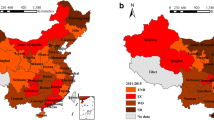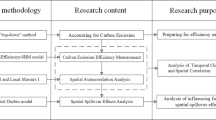Abstract
The economic and social development of a country rely heavily on transportation. In China, it has become the third largest energy consumption sector and generates substantial amounts of carbon emissions. In the present study, direct and indirect carbon emissions from the transportation industry throughout China’s 30 provinces during 1997–2017 were calculated. Further, to reveal the spatio-temporal characteristics of the relationship between carbon emissions and economic growth, the standard deviational ellipse and Tapio decoupling method were employed. The main results are as follows. (1) The total carbon emissions from the transportation industry increased from 132.79 million tons (Mt) in 1997 to 849.64 Mt in 2017, with an average annual growth rate of 9.72%; direct carbon emissions accounted for approximately 86% of the total. (2) Carbon emissions as well as the added value of the transportation industry had the same spatial distribution characteristics, presenting a northeast–southwest pattern during 1997–2017. Although their spatial distribution patterns were mainly in the north–south direction, the development in the east–west direction became increasingly obvious. (3) The decoupling index in the transportation industry was greater than 0.8 for most years, with an expansive negative decoupling state or an expansive coupling state. The differences in carbon emissions and economic growth between various provinces showed a spatio-temporal disparity of the decoupling states in the transportation industry. The obtained results are of considerable interest for China’s policymakers to set more reasonable carbon emission reduction goals and implement targeted policies according to the carbon emission situation at a local scale.








Similar content being viewed by others
References
Alshehry AS, Belloumi M (2017) Study of the environmental Kuznets curve for transport carbon dioxide emissions in Saudi Arabia. Renew Sust Energ Rev 75:1339–1347
Anselin L (2010) Thirty years of spatial econometrics. Pap Reg Sci 89:3–25
Ascensão F, Fahrig L, Clevenger AP, Corlett RT, Jaeger JA, Laurance WF, Pereira HM (2018) Environmental challenges for the Belt and Road Initiative. Nature Sustainability 1:206–209
Bai C, Chen Y, Yi X, Feng C (2019) Decoupling and decomposition analysis of transportation carbon emissions at the provincial level in China: perspective from the 11th and 12th Five-Year Plan periods. Environ Sci Pollut Res Int 26:15039–15056
Benassi F, Lipizzi F, Strozza S (2019) Detecting foreigners’ spatial residential patterns in urban contexts: two tales from Italy. Applied Spatial Analysis and Policy 12:301–319
Cai W, Wang C, Lu X, Chen J (2006) The carbon dioxide emission reduction potential in China’s road transport sector in 2020. Wit Trans Built Env 89:669–678
Chen CL, Yin XP (2011): Analysis of decoupling the link between transport and carbon emissions—case of railway transport in China. 2011 International Conference on Electronics, Communications and Control (ICECC), 3543–3546
Chen T, Deng S, Li M (2018) Spatial patterns of satellite-retrieved PM2.5 and long-term exposure assessment of China from 1998 to 2016. Int J Env Res Pub He 15
China Emission Accounts and Datasets (CEADs), 2019. Emission inventory construction method. http://www.ceads.net/data/inventory-by-sectoral-approach/ (Accessed 26 November 2019)
Dogan E, Inglesi-Lotz R (2020) The impact of economic structure to the environmental Kuznets curve (EKC) hypothesis: evidence from European countries. Environ Sci Pollut Res:1–8
Dong JF, Huang JY, Wu RW, Deng C (2017) Delinking indicators on transport output and carbon emissions in Xinjiang, China. Pol J Environ Stud 26:1045–1056
Du Q, Zhou J, Pan T, Sun Q, Wu M (2019) Relationship of carbon emissions and economic growth in China’s construction industry. J Clean Prod 220:99–109
Duan HB, Hu MW, Zhang YK, Wang JY, Jiang WP, Huang QF, Li JH (2015) Quantification of carbon emissions of the transport service sector in China by using streamlined life cycle assessment. J Clean Prod 95:109–116
Eryando T, Susanna D, Pratiwi D, Nugraha F (2012) Standard deviational ellipse (SDE) models for malaria surveillance, case study: Sukabumi district-Indonesia, in 2012. Malar J 11:P130
Fan FY, Lei YL (2016) Decomposition analysis of energy-related carbon emissions from the transportation sector in Beijing. Transport Res D-Tr E 42:135–145
Fang DL, Chen B (2019) Inequality of air pollution and carbon emission embodied in inter-regional transport. Enrgy Proced 158:3833–3839
Guo MY, Meng J (2019) Exploring the driving factors of carbon dioxide emission from transport sector in Beijing-Tianjin-Hebei region. J Clean Prod 226:692–705
Han XY, Xu YQ, Kumar A, Lu XW (2018) Decoupling analysis of transportation carbon emissions and economic growth in China. Environ Prog Sustain 37:1696–1704
He CH 2012: Research on low carbon traffic development of Shanghai based on the LMDI model Hefei University of Technology (in Chinese), Heifei, 28 pp
He KB, Huo H, Zhang Q, He DQ, An F, Wang M, Walsh MP (2005) Oil consumption and CO2 emissions in China’s road transport: current status, future trends, and policy implications. Energ Policy 33:1499–1507
Intergovernmental Panel on Climate Change (IPCC), 2006. IPCC guidelines for national greenhouse gas inventories. (Institute for Global Environmental Strategies (IGES), 2006)
Katumba S, Cheruiyot K, Mushongera D (2019) Spatial change in the concentration of multidimensional poverty in Gauteng, South Africa: evidence from quality of life survey data. Soc Indic Res 145:95–115
Lefever DW (1926) Measuring geographic concentration by means of the standard deviational ellipse. Am J Sociol 32:88–94
Lin B, Xie C (2014) Reduction potential of CO2 emissions in China’s transport industry. Renew Sust Energ Rev 33:689–700
Liu Z, Geng Y, Dai H, Wilson J, Xie Y, Wu R, You W, Yu Z (2018) Regional impacts of launching national carbon emissions trading market: a case study of Shanghai. Appl Energy 230:232–240
Loo BPY, Li LN (2012) Carbon dioxide emissions from passenger transport in China since 1949: implications for developing sustainable transport. Energ Policy 50:464–476
Lu SR, Jiang HY, Liu Y, Huang S (2017) Regional disparities and influencing factors of average CO2 emissions from transportation industry in Yangtze River Economic Belt. Transport Res D-Tr E 57:112–123
Ma F, Wang WL, Sun QP, Liu F, Li XD (2018) Ecological pressure of carbon footprint in passenger transport: spatio-temporal changes and regional disparities. Sustainability-Basel 10
Ma H, Sun W, Wang S, Kang L (2019a) Structural contribution and scenario simulation of highway passenger transit carbon emissions in the Beijing-Tianjin-Hebei metropolitan region, China. Resour Conserv Recycl 140:209–215
Ma XJ, Wang CX, Dong BY, Gu GC, Chen RM, Li YF, Zou HF, Zhang WF, Li QN (2019b) Carbon emissions from energy consumption in China: its measurement and driving factors. Sci Total Environ 648:1411–1420
Muhammad R, Zhao Y, Liu F (2019): Spatiotemporal analysis to observe gender based check-in behavior by using social media big data: a case study of Guangzhou, China. Sustainability-Basel 11
National Climate Change Division, 2018. Controlling greenhouse gas emission [Chinese document]. http://qhs.mee.gov.cn/kzwsqtpf/201812/t20181220_685481.shtml (Accessed 26 November 2019)
Organization for Economic Cooperation and Development (OECD) (2002) Indicators to measure decoupling of environmental pressure from economic growth. OECD Report, Organization for Economic Cooperation and Development, Paris
P. R. China National Development and Reform Commission (NDRC), 2011. Guidelines for provincial greenhouse gas inventories [Chinese document]. (2011)
Ru H (2018) Government credit, a double-edged sword: evidence from the China Development Bank. J Financ 73:275–316
Shan Y, Liu J, Liu Z, Xu X, Shao S, Wang P, Guan D (2016) New provincial CO2 emission inventories in China based on apparent energy consumption data and updated emission factors. Appl Energy 184:742–750
Shan Y, Guan D, Zheng H, Ou J, Li Y, Meng J, Mi Z, Liu Z, Zhang Q (2018) China CO2 emission accounts 1997–2015. Scientific Data 5:170201
Shi YS, Matsunaga T, Yamaguchi Y, Li ZQ, Gu XF, Chen XH (2018) Long-term trends and spatial patterns of satellite-retrieved PM2.5 concentrations in South and Southeast Asia from 1999 to 2014. Sci Total Environ 615:177–186
Shi K, Yu B, Zhou Y, Chen Y, Yang C, Chen Z, Wu J (2019) Spatiotemporal variations of CO2 emissions and their impact factors in China: a comparative analysis between the provincial and prefectural levels. Appl Energy 233:170–181
Tapio P (2005) Towards a theory of decoupling: degrees of decoupling in the EU and the case of road traffic in Finland between 1970 and 2001. Transp Policy 12:137–151
Wang Q, Wang SS (2019) A comparison of decomposition the decoupling carbon emissions from economic growth in transport sector of selected provinces in eastern, central and western China. J Clean Prod 229:570–581
Wang ZH, Yang L (2015) Delinking indicators on regional industry development and carbon emissions: Beijing-Tianjin-Hebei economic band case. Ecol Indic 48:41–48
Wang Y, Zhu Q, Geng Y (2013) Trajectory and driving factors for GHG emissions in the Chinese cement industry. J Clean Prod 53:252–260
Wang Y, Li K, Xu X, Zhang Y (2014) Transport energy consumption and saving in China. Renew Sust Energ Rev 29:641–655
Wang WW, Li M, Zhang M (2017a) Study on the changes of the decoupling indicator between energy-related CO2 emission and GDP in China. Energy 128:11–18
Wang Y, Xie T, Yang S (2017b) Carbon emission and its decoupling research of transportation in Jiangsu Province. J Clean Prod 142:907–914
Wang B, Sun Y, Chen Q, Wang Z (2018a) Determinants analysis of carbon dioxide emissions in passenger and freight transportation sectors in China. Struct Chang Econ Dyn 47:127–132
Wang B, Sun YF, Wang ZH (2018b) Agglomeration effect of CO2 emissions and emissions reduction effect of technology: a spatial econometric perspective based on China’s province-level data. J Clean Prod 204:96–106
Xu B, Lin B (2018) Investigating the differences in CO2 emissions in the transport sector across Chinese provinces: evidence from a quantile regression model. J Clean Prod 175:109–122
Xu J, Zhao Y, Zhong K, Zhang F, Liu X, Sun C (2018) Measuring spatio-temporal dynamics of impervious surface in Guangzhou, China, from 1988 to 2015, using time-series Landsat imagery. Sci Total Environ 627:264–281
Zhang T, Zeng A (2013) Spatial econometrics analysis on China transport carbon emissions. Urban Development Studies 20:14–20 (in Chinese)
Zhang S, Wang J, Zheng W (2017) Spatio-temporal difference of transportation carbon emission and its influencing factors in China. Acta Scientiae Circustantiae 37:4787–4797 (in Chinese)
Zhao YL, Kuang YQ, Huang NS (2016): Decomposition analysis in decoupling transport output from carbon emissions in Guangdong Province, China. Energies 9
Zhou G, Chung W, Zhang X (2013) A study of carbon dioxide emissions performance of China’s transport sector. Energy 50:302–314
Zhou S, Yan Y, Yang XM (2014) Measuring carbon dioxide emissions from the Chinese transport sector. P I Civil Eng-Transp 167:306–321
Zhu C, Gao D (2019) A research on the factors influencing carbon emission of transportation industry in “the Belt and Road Initiative” countries based on panel data. Energies 12:2405
Funding
This work is supported by the National Nature Science Foundation of China (grant number 41630644).
Author information
Authors and Affiliations
Contributions
All authors have read and approve the paper.
Corresponding author
Ethics declarations
Conflict of interest
The authors declare that they have no conflict of interest.
Additional information
Responsible Editor: Muhammad Shahbaz
No part of this paper has been published or submitted elsewhere.
Publisher’s note
Springer Nature remains neutral with regard to jurisdictional claims in published maps and institutional affiliations.
Rights and permissions
About this article
Cite this article
Wang, L., Fan, J., Wang, J. et al. Spatio-temporal characteristics of the relationship between carbon emissions and economic growth in China’s transportation industry. Environ Sci Pollut Res 27, 32962–32979 (2020). https://doi.org/10.1007/s11356-020-08841-x
Received:
Accepted:
Published:
Issue Date:
DOI: https://doi.org/10.1007/s11356-020-08841-x




